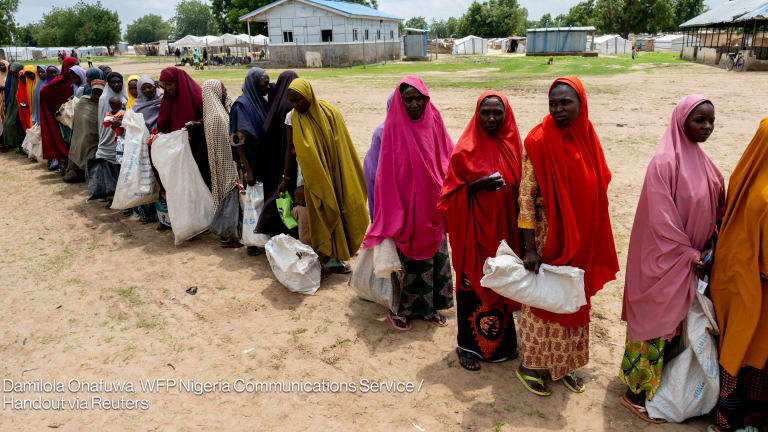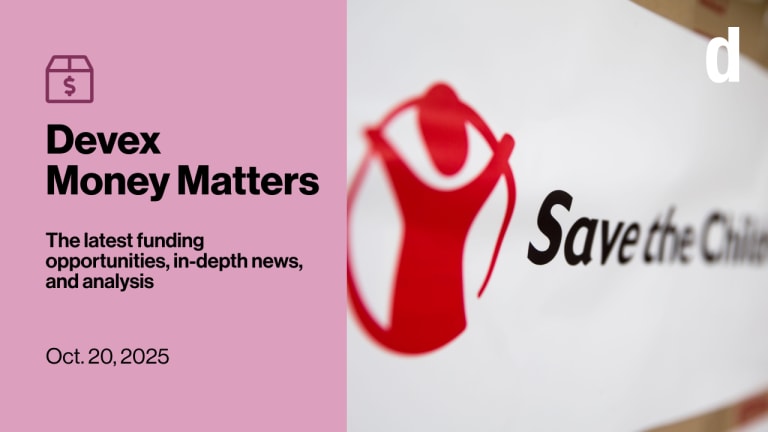3 years after Typhoon Haiyan, data reveals lessons in funding and rehabilitation
Three years after Typhoon Haiyan struck the Philippines, the complex dynamics surrounding the long-term rehabilitation of affected communities prompted us to dig into the available data and assess some of the accomplishments and setbacks.
Three years ago, the strongest typhoon ever known to make landfall ravaged the Philippines and triggered one of the world’s biggest humanitarian catastrophes and relief and recovery operations. More than 16 million people were affected by Typhoon Haiyan (local name Yolanda), approximately 7,350 people died, 4.1 million were displaced and 1 million homes were destroyed. Losses were pegged at approximately $300 million. Because most of the affected area was extremely impoverished, 1 in 3 families were especially vulnerable to loss of income and shelter. The hardest hit areas, notably the Eastern Visayas region, experienced double-digit increases in poverty incidence. In addition to the colossal damage, Haiyan was extraordinary because video of the event and aftermath were streamed into living rooms and offices worldwide. The dramatic storm surge — which caused the most devastation — was not predicted, but the typhoon’s direction and intensity was forecasted a couple days in advance, which allowed some media organizations to position themselves on the ground prior to the storm and share what they saw. Other distressing footage was captured and revealed on individual smartphones and devices. In the weeks following the storm, journalists from around the world traveled to the Philippines to cover Haiyan. It seemed an ongoing crisis unfolding in real time. And it solicited a near unprecedented global reaction and outpouring of support. Today, the desperate images from Tacloban — Haiyan’s ground zero — remains etched in the public’s memory. High-ranking diplomats visit the area every so often. The international development community continues its important work. But for the most part we have moved on. Even in the Philippines, media attention and memorials have died down, although, thanks to public awareness over Haiyan, the country appears more prepared to deal with the next natural disaster. While Tacloban is more or less back on its feet, the poorer rural areas which we have visited — those more isolated and more dependent on subsistence farming and fishing — continue to feel the legacy pain from Haiyan. Re-establishing sustainable livelihoods and permanently resettling vulnerable families remain among the more stubborn challenges. The enduring Haiyan story and complex dynamics surrounding the long-term rehabilitation of affected communities prompted us to dig into the available data and assess some of the accomplishments and setbacks. Among the many important components of the international response effort was a commitment to better track donor contributions and metrics on the ground. The good news is that by and large valid and updated data is available and we were able to use it to analyze Haiyan aid from the time immediate relief activities began to the current state. Specifically, we studied the multiple finance tracking systems that were put in place during the early recovery phases, including the financial tracking service of the United Nations Office for the Coordination of Humanitarian Affairs, the Philippine Department of Budget and Management’s Haiyan rehabilitation and reconstruction program, the Organization for Economic Cooperation and Development, and the Philippine government’s Foreign Aid Transparency Hub, or FAiTH, which all combined tell an instructive development story of the last three years. To verify the information and our findings, we also interviewed other Philippine government leaders, U.N. officials, and NGO and civil society representatives involved in the response and rehabilitation. Here’s what we found out. 1. Haiyan money was big, but not big enough. The Haiyan appeal was one of the largest launched by the U.N. in 2013, urging the world to commit at least $776 million to its Strategic Response Plan. But the international community managed to muster just $469 million or 60 percent of the requested amount leaving a shortfall of $306 million. Meanwhile, contributions, pledges and commitments outside the U.N. response framework totaled $396 million. Combined with the U.N.’s SRP funding, the size of the international humanitarian economy for the Haiyan response was $865 million. “Due to the scale and long period of reconstruction, [the funding cannot fully] cover the rehabilitation of the whole affected area. Obviously, the scenario is that some families will be deprived of the services they need most and recovery could take even longer,” said Charlie Ayco, Habitat for Humanity in the Philippines. 2. Long-term interventions suffered from funding gaps. The SRP funding shortfall plagued the responses to certain sector groupings, or as the U.N. humanitarian agency calls them, clusters. Reflecting the priorities of 14 U.N. agencies and 40 international nongovernmental organizations and local partners, the SRP is designed to complement the Philippine government’s own action plan, called the Yolanda Recovery and Rehabilitation Plan. Based on data from U.N. humanitarian agency, the SRP’s widest gaps were in longer-term interventions. The shelter and protection clusters operated with an estimated 50 percent deficit, while the livelihoods cluster suffered a gap of 71 percent. On the other hand, the clusters that suffered the least deficit were in “supply-driven,” short-term assistance such as distributing food packs and potable water deliveries. So the challenge was not so much during the relief and early recovery phase — which generally spans six months to a year in the case of Haiyan. Rather, it was in the transition to long-term recovery. “There was a danger of fixating on quick wins, which was okay during the early phase of the response. But eventually, there had to be a shift to longer-term, forward-looking humanitarian assistance,” said Esteban Bong Masagca of People's Disaster Risk Reduction Network. 3. As the emergency slowed, so did aid disbursement. The Haiti earthquake in 2010 compelled the humanitarian community to devise a better system of mobilizing resources so the Inter-Agency Standing Committee established the process for Level 3 activation. This exceptional measure is applied for the most catastrophic situations where the gravity justifies mobilization beyond normal levels. Despite Haiyan’s Level 3 classification, aid was not particularly sustainable over time, even when compared to Haiti which required significantly more cumulative aid. International aid flowed effectively in the early weeks of the Haiyan response, with as much as $13 million coming in per day in 2013, but narrowed to $34,000 in 2015. Comparatively, Haiti funding sustained steady momentum over the same period of time. 4. Other humanitarian crises likely affected the Haiyan appeal. From 2013 to 2014, the humanitarian community was facing the most Level 3 emergencies (natural or man-made) at any one time: Syria, Philippines, Central African Republic and later, South Sudan and Iraq. The Haiyan appeal would have the biggest shortfall that year among all Level 3 emergencies except for Syria. Globally, the U.N. appealed for a massive $18 billion to respond to all the emergencies in the world. This was a 528 percent increase in 10 years. The international community managed to pull together $10.8 billion. And while this broke the record as the highest humanitarian giving of all time, it still left a $7.2 billion gap. 5. More to do on localization. Three major groups dominated Haiyan’s international funding landscape. The vast majority of funding was granted to U.N. agencies with an aggregate of $353 million or 41 percent of the total funding pool. Nonprofits, INGOs and alliances were next with $246 million. Of this number, a third went to faith-based organizations including World Vision, Catholic Relief Services, and ACT Alliance. The International Federation of Red Cross and Red Crescent Societies came in third with an aggregate of $112 million or 13 percent of the total. Collectively, these groups commanded considerable influence and resources across the Haiyan response. Devex analysis indicates that U.N. agencies and large INGOs received about 80 percent of foreign assistance and only 2.4 percent was channeled directly to front-line organizations based in the Philippines. While it is difficult to determine precisely how much of the U.N. and INGO funding was subgranted to local organizations, the representatives interviewed for this article stressed that local groups played and continue to play key roles in program implementation. “We need to work on the humanitarian system to make it more diverse and less exclusive. There is a danger that newer, smaller NGOs may be sidelined in favor of the more established players. The international humanitarian community must respect, complement and support national and local capacities,” said Masagca. 6. Private sector stepped up. The private sector — private individuals, corporations and charities — donated more than $98 million toward Haiyan recovery, representing the second largest source of aggregate contributions. The United Kingdom granted $123 million to Haiyan recovery, while the United States provided over $90 million. The money donated by the private sector went to more than 30 U.N. agencies and INGOs, the biggest flows going to IFRC, Americares, U.N. agencies, World Vision and ACT Alliance. Haiyan’s top 10 institutional donors make up more than 70 percent of the total contributions. Eight of them are traditional donors or established multilateral agencies. “The private sector, local organizations, and the strong civil society network in the Philippines are all positive aspects that can be used to leverage and scale up the recovery efforts,” said Richard Higgins, UNOCHA humanitarian assistance analyst. 7. Domestic funds eclipsed international aid. The Philippine government’s expenditure has overshadowed and outpaced international donor assistance by as much as $1.3 billion. Based on data from the Philippines’ budget agency, the money released for Haiyan amounted to 93.9 billion Philippine pesos ($2.1 billion) from 2013 to 2015. An additional 1 billion Philippine pesos has been earmarked for year 2016. The money was sourced from regular budget items — such as the National Risk Reduction and Management Fund — as well as savings and unprogrammed funds. The response to Haiyan has prompted a renewed appreciation of the crucial role of domestic governments. “The international community cannot build a country from the ground up. The government should take the lead,” Kasper Engborg, former head of U.N. operations in Tacloban, Philippines, told Devex. 8. Housing is the weak spot. Of the 26 targets laid out by the Philippine government, the resettlement program suffered the greatest setbacks. It has been hampered both by technical and legal issues, resulting in the lowest completion rate in the government’s 26-point program. In an interview, the Office of Vice President Leni Robredo, who is also chair of the Housing and Urban Development Coordinating Council, pointed to “scarcity of suitable land and bureaucratic red tape” for the delays. The Department of Social Welfare and Development is also investigating reported anomalies in the implementation of the Emergency Shelter Assistance. Meanwhile, it will take at least a year more before the resettlement program is finally near completion. “We are looking to complete 90 percent of the target by 2017,” said Rizalde Mediavillo of the National Housing Authority. Nonetheless, the humanitarian community “did a commendable job with the activation of sector clusters, which helped to manage some of the quality control, and coordinated distribution of aid,” said Ramsey Rayyis, program coordinator from the Philippine Red Cross. As many INGOs wind down operations this year, the hope is that “these last three years have given opportunities for people to stand on their own,” said Rayyis. Lean Santos contributed reporting. Read more international development news online, and subscribe to The Development Newswire to receive the latest from the world’s leading donors and decision-makers — emailed to you FREE every business day.
Three years ago, the strongest typhoon ever known to make landfall ravaged the Philippines and triggered one of the world’s biggest humanitarian catastrophes and relief and recovery operations. More than 16 million people were affected by Typhoon Haiyan (local name Yolanda), approximately 7,350 people died, 4.1 million were displaced and 1 million homes were destroyed.
Losses were pegged at approximately $300 million. Because most of the affected area was extremely impoverished, 1 in 3 families were especially vulnerable to loss of income and shelter. The hardest hit areas, notably the Eastern Visayas region, experienced double-digit increases in poverty incidence.
In addition to the colossal damage, Haiyan was extraordinary because video of the event and aftermath were streamed into living rooms and offices worldwide. The dramatic storm surge — which caused the most devastation — was not predicted, but the typhoon’s direction and intensity was forecasted a couple days in advance, which allowed some media organizations to position themselves on the ground prior to the storm and share what they saw. Other distressing footage was captured and revealed on individual smartphones and devices.
This article is free to read - just register or sign in
Access news, newsletters, events and more.
Join usSign inPrinting articles to share with others is a breach of our terms and conditions and copyright policy. Please use the sharing options on the left side of the article. Devex Pro members may share up to 10 articles per month using the Pro share tool ( ).
Alaysa Escandor is a former development analyst based in Manila, Philippines. She covered a wide range of development and humanitarian aid issues since. She was a fellow at the Konrad Adenauer Asian Center for Journalism. Her interests include humanitarian and development aid, health and gender.








